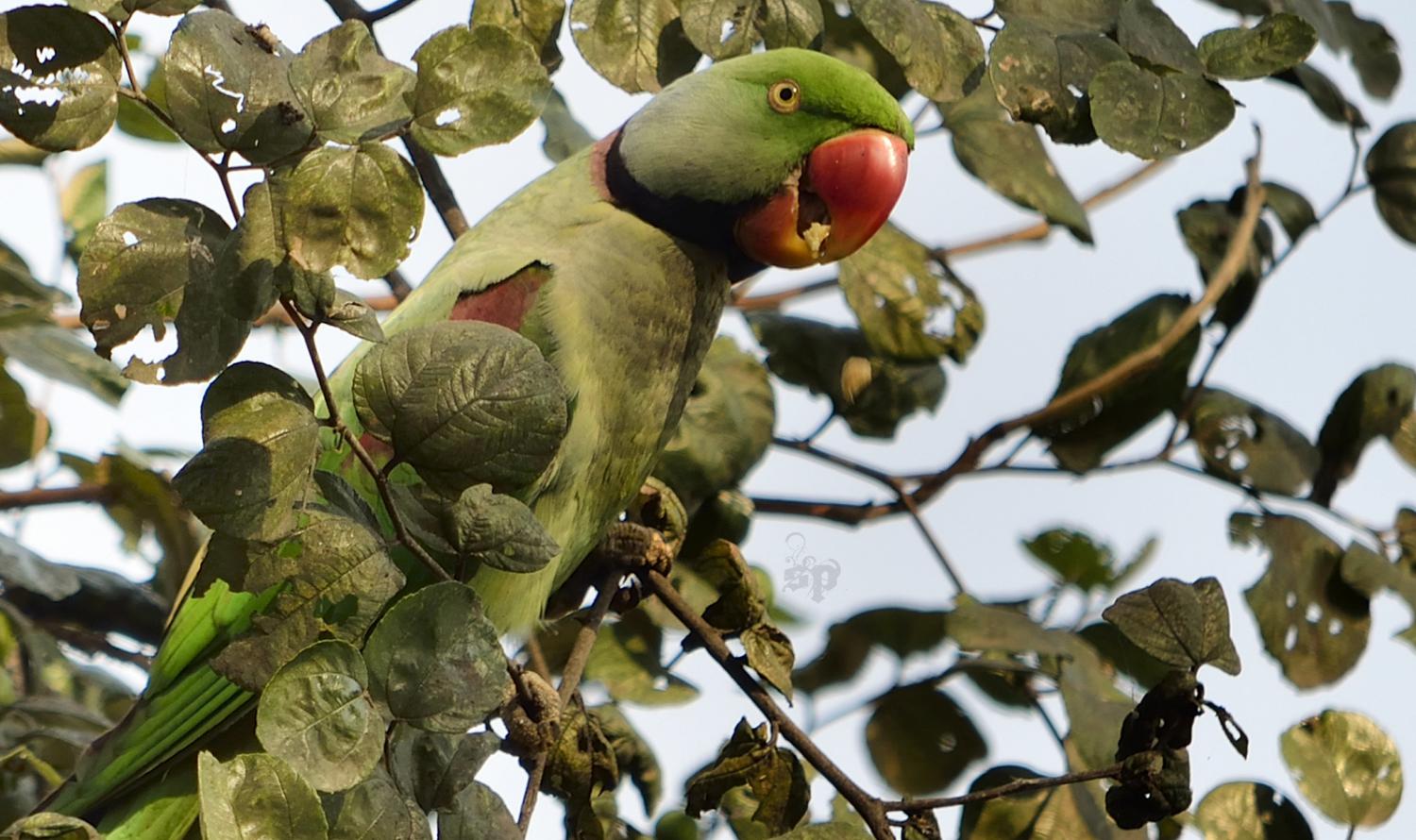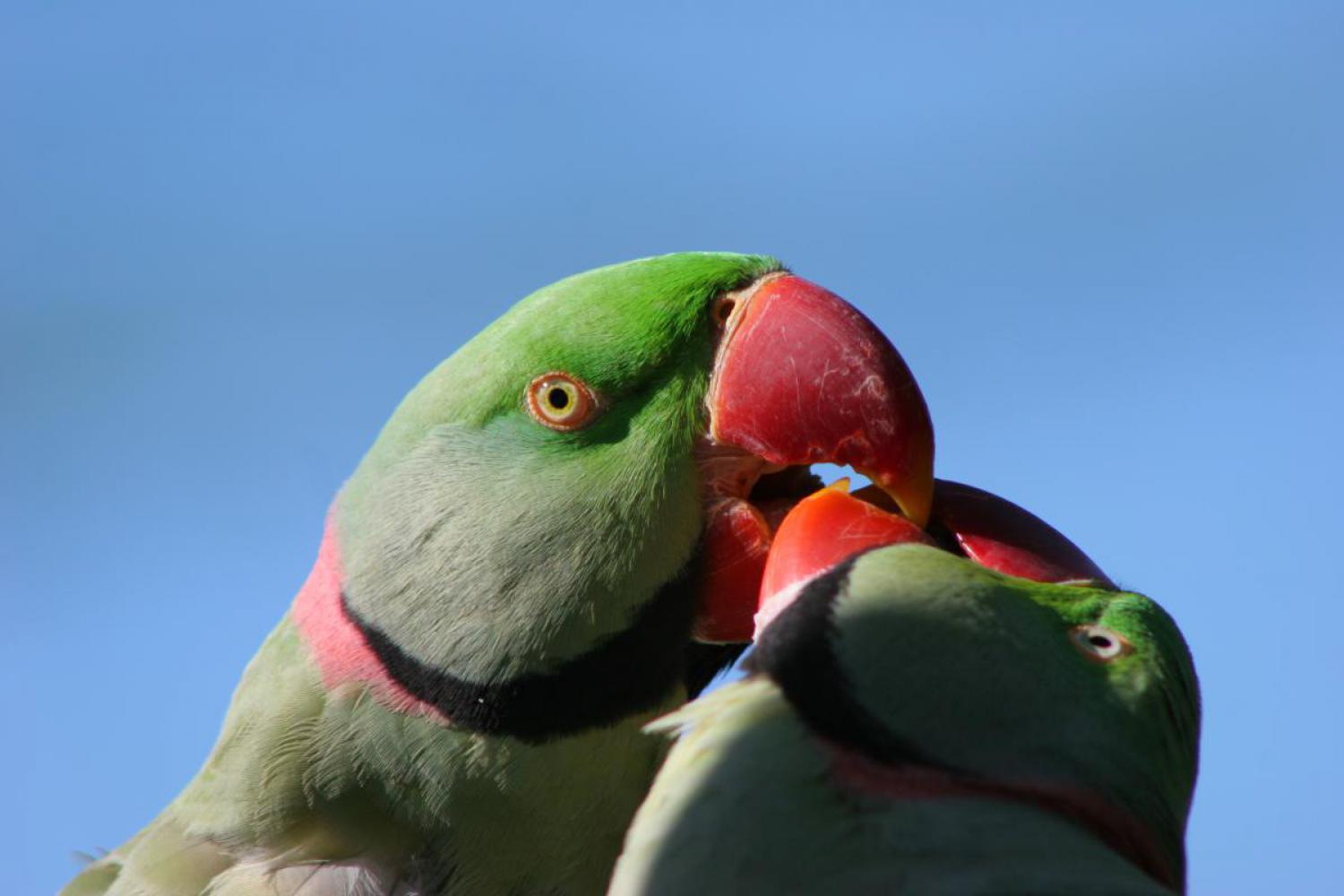Species of Thailand
Alexandrine parakeet
Psittacula eupatria
Carolus Linnaeus, 1766
In Thai: นกแก้วโม่ง
The Alexandrine parakeet (Psittacula eupatria), also known as the Alexandrine parrot, is a medium-sized parrot in the genus Psittacula of the family Psittacidae. It is named after Alexander the Great, who transported numerous birds from Punjab to various European and Mediterranean countries and regions, where they were prized by the royalty, nobility and warlords.
The Alexandrine parakeet has established feral populations in Spain, England, Belgium, the Netherlands, Germany, Turkey, Saudi Arabia, Bahrain, Qatar, the United Arab Emirates, Iran, Hong Kong where it lives alongside feral populations of its close relative, the rose-ringed parakeet (Psittacula krameri).
Taxonomy and etymology
The Alexandrine parakeet was first described by French zoologist Mathurin Jacques Brisson as Psittaca Ginginiana or "La Perruche de Gingi" (The Gingi's Parakeet) in 1760; after the town of Gingee in southeastern India, which was a French outpost then. The birds may, however, merely have been held in captivity there. Carl Linnaeus redescribed the Alexandrine parakeet in 1766 as Psittacus eupatria.
The genus name Psittacula is a diminutive of the Latin word meaning "parrot", and the specific name eupatria is derived from the Ancient Greek words meaning "well" and meaning "descent".
Phylogeny
Genetic analysis of the mitochondrial cytochrome b sequences of Psittacula parakeets has shown that the Alexandrine parakeet diverged from the lineage that gave rise to the rose-ringed parakeet (Psittacula krameri) and the Mauritius parakeet (Psittacula eques) about 5 million years ago.
Description
The Alexandrine parakeet is one of the largest parakeets, measuring 56 to 62 cm from the top of the head to the tip of the tail and weighing 200 to 300 g. The tail measures 28 to 35 cm. It is predominantly green with a light blue-grey sheen on the cheeks and nape (back of the neck), yellow-green abdomen, red patch on the shoulders and massive red beak with yellow tips. The upper-side of the tail passes from green at the top to blue further down, and is yellow at the tip. The underside of the tail is yellow.
Adults are sexually dimorphic. Adult males have a black stripe across their lower cheeks and a pink band on their nape. Adult females lack both a black stripe across their lower cheeks and a pink band on their nape. The young are similar in appearance to adult females but have shorter tails.
Subspecies
Five subspecies of the Alexandrine parakeet are currently recognized. Information on the distribution and plumage differences of the different subspecies is given below.
| Subspecies | Distribution | Notes |
|---|---|---|
| Nominate Alexandrine parakeet (P. e. eupatria) | Western India, South India and Sri Lanka. | Nominate subspecies |
| Large Indian parakeet (P. e. nipalensis) | Eastern Afghanistan, Pakistan, North India, Central India, East India, Nepal and Bhutan. | It is larger than the nominate subspecies and more greyish-green. The back of the head and cheeks are washed with blue. Adult males have a broader black stripe across the lower cheek. |
| Large Burmese parakeet (P. e. avensis) | Northeast India, Bangladesh and Myanmar. | It has a smaller beak than the nominate subspecies. Males look like P. e. nipalensis, however the neck and underparts are more yellowish and there is a narrow blue stripe on the hindneck. |
| Large Andaman parakeet (P. e. magnirostris) | Andaman Islands and Coco Islands. | It is slightly larger than the nominate subspecies, and has a larger beak and brighter shoulder patch. Males have a narrow blue stripe above the nape band. |
| Thai rose-ringed parakeet (P. e. siamensis) | Vietnam, Cambodia, Laos and Thailand. | It is smaller than the nominate subspecies and has a paler shoulder patch. It also has a yellowish face and neck. Males look like P. e. avensis, however the back of the head and nape are washed with blue. |
Ecology and behaviour
The Alexandrine parakeet lives in forests, woodlands, agricultural lands and mangrove forests at elevations of up to 900 m (3, 000 ft). It eats a variety of wild and cultivated seeds, buds, fruits and nuts. Flocks can cause extensive damage to ripening fruits and grain crops like maize and jowar. It usually lives in small flocks, but forms larger groups in areas where food is abundant or at communal roosts.
The Alexandrine parakeet has a variety of calls, including a ringing trrrieuw, loud kree-aar or keeak, deep klak-klak-klak-klak and resonant gr-aak. Its calls are usually deeper, harsher and more resonant than those of the rose-ringed parakeet. Its voice becomes harsher when alarmed, and it shrieks loudly when mobbing predators. Flocks occasionally excitedly vocalize together. It is known to imitate human speech in captivity.
Breeding
Alexandrine parakeets breed from November to April in their native range. They usually nest in tree hollows, but sometimes use tree holes excavated by themselves or cracks in buildings. Females lay 2 to 4 white, blunt oval-shaped eggs, measuring 27 to 34 mm. The average incubation period is 24 days. The chicks fledge at about 7 weeks of age, and are dependent on their parents until 3 to 4 months of age.
Aviculture
Alexandrine parakeets are relatively popular pet birds due to their long lifespan in captivity, playful behaviour and ability to mimic human speech. Alexander the Great is thought to have kept one as a pet. They are one of the most sought-after cage birds in the Indian market. According to CITES trade data, at least 57, 772 Alexandrine parakeets were imported into countries outside their native range between 1981 and 2014.
Conservation
The Alexandrine parakeet is listed as near threatened by the International Union for Conservation of Nature (IUCN) because of its steep population decline in its native range due to habitat loss, persecution and excessive capture to cater to the demands of the illegal wildlife trade. It is sporadic in South India, uncommon in Bangladesh, and declining in North Bengal and certain parts of Sri Lanka. It has suffered the greatest population declines in the Sindh and Punjab provinces of Pakistan, Laos, northwestern and southwestern Cambodia, and Thailand.
The sale of Alexandrine parakeets is banned in Pakistan, but they can be found being openly sold in the markets of Lahore and Rawalpindi. Their sale is also banned in India, and yet they are sold in broad daylight in urban bird markets, suggesting that the Indian government is allocating insufficient resources for their protection.
Culture
Sri Lanka, Vietnam, Thailand, Mongolia and Iran have issued postage stamps depicting the Alexandrine parakeet.
This article uses material from Wikipedia released under the Creative Commons Attribution-Share-Alike Licence 3.0. Eventual photos shown in this page may or may not be from Wikipedia, please see the license details for photos in photo by-lines.
Category / Seasonal Status
Wiki listed status (concerning Thai population): Rare, much reduced
BCST Category: Recorded in an apparently wild state within the last 50 years
BCST Seasonal status: Resident or presumed resident
Scientific classification
- Kingdom
- Animalia
- Phylum
- Chordata
- Class
- Aves
- Order
- Psittaciformes
- Family
- Psittacidae
- Genus
- Psittacula
- Species
- Psittacula eupatria
Common names
- English: Alexandrine parakeet
- Thai: นกแก้วโม่ง
Synonyms
- Psittacus eupatria, Carolus Linnaeus (1766)
Conservation status

Near Threatened (IUCN3.1)

Near Threatened (BirdLife)

Endangered (ONEP)
Photos
Please help us review the bird photos if wrong ones are used. We can be reached via our contact us page.
Range Map

- Bang Kruai District, Nonthaburi
- Bang Pahan District, Phra Nakhon Si Ayutthaya
- Bang Pu Recreation Centre
- Bangkok Province
- Mueang Chiang Mai District, Chiang Mai
- Mueang Chonburi District, Chonburi
- Mueang Nonthaburi District, Nonthaburi
- Mueang Pathum Thani District, Pathum Thani
- Pho Prathap Chang District, Phichit
- Sai Yok District, Kanchanaburi
- Samut Prakan Province
- Sanam Bin Reservoir Non-Hunting Area
- Wat Phai Lom & Wat Ampu Wararam Non-Hunting Area

